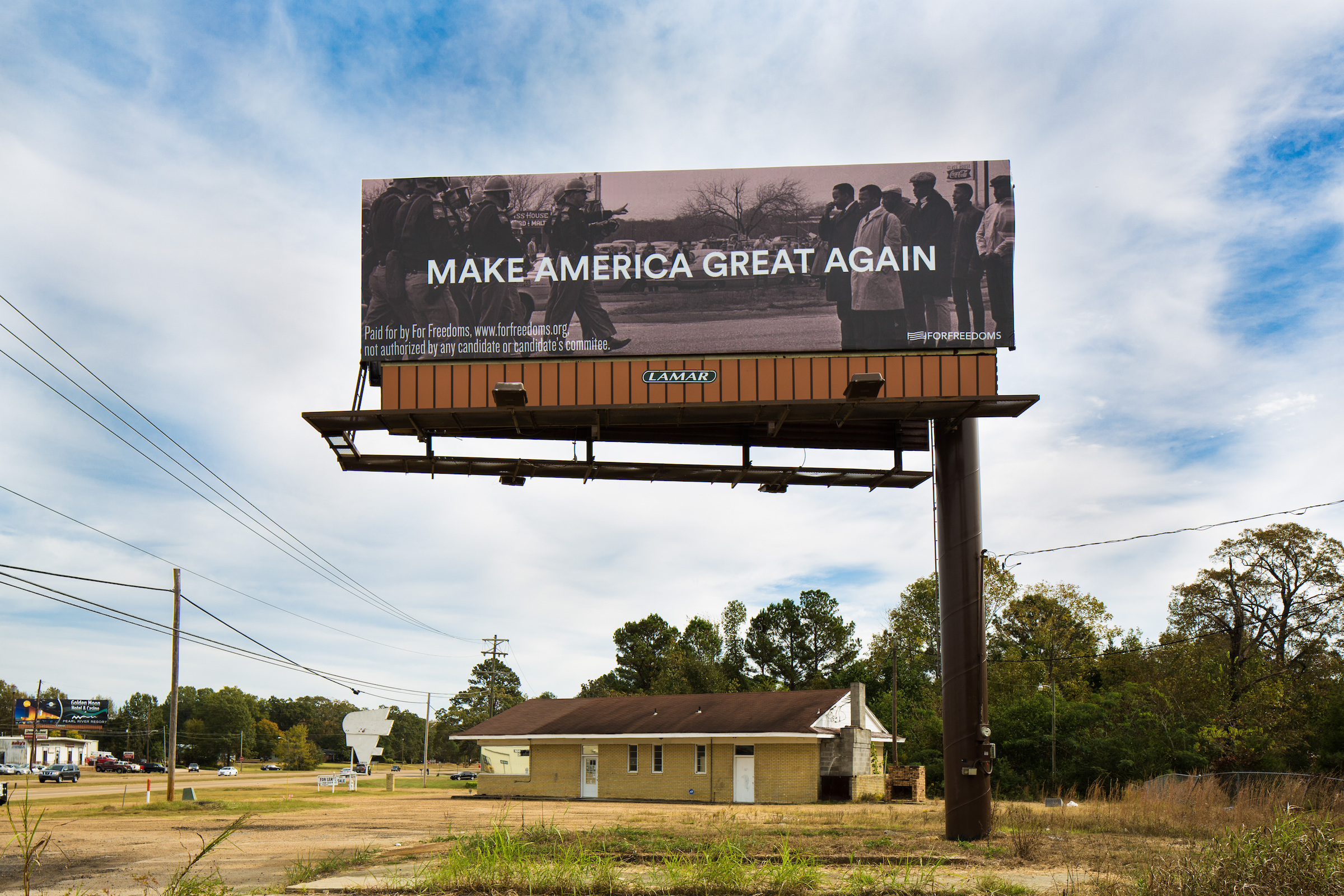Montgomery Mayor Steven Reed has requested the removal of a billboard artwork featuring a historic photograph from Selma’s infamous “Bloody Sunday” overlaid with the Trump campaign slogan “Make America Great Again.” The image had captured the attention of the conservative Alabama media outlet 1819 News earlier this week.
Designed by the art collective For Freedoms, founded by artists Eric Gottesman, Hank Willis Thomas, and Michelle Woo in 2016, the billboard artwork reproduces civil rights photographer Spider Martin’s iconic 1965 image “Two Minute Warning.” The photo captured the moment before state troopers charged toward civil rights leaders Hosea Williams and John Lewis on Bloody Sunday, when a police mob attacked hundreds of marchers crossing the Edmund Pettus Bridge in Selma to advocate for voting rights. Months later, Congress passed the Voting Rights Act, which mandated the enforcement of the 15th Amendment right to vote and outlawed voting discrimination practices.
In a statement posted on X, Mayor Reed cited the “politicized” nature of For Freedoms’s design as well as the need to be careful about imagery of Bloody Sunday’s “pivotal” legacy in the civil rights movement among the reasons for requesting the image’s removal from the billboard “without delay.”
“We must be extremely mindful of how we use such images of our shared history, especially when they risk being perceived as politically charged,” wrote Reed, a Democrat who became Montgomery’s first Black mayor in 2019. “Our history deserves to be treated with the utmost respect and care, ensuring it unites rather than divides us as a community.”
The exact location of the For Freedoms billboard artwork in Montgomery is unclear and could not be confirmed by the mayor’s office or the collective.
When reached by Hyperallergic, Reed said that the work was part of a temporary public art installation funded and contracted by the City. He wrote on X that the Montgomery Museum of Fine Arts (MMFA) had purchased the billboard.

Tracy Martin, the daughter of Spider Martin, who passed away in 2003, told Hyperallergic she gave For Freedoms permission to use her father’s photograph as part of an ongoing collaboration with Thomas, one of the organization’s co-founders.
“I’m not in agreement with taking the For Freedoms boards down,” Martin said, calling Reed’s directive a “violation of freedom of speech.”
“These boards ask the question: When was America great?” Martin continued. “The MAGA slogan has been clear for many years, and as far as we know, the person who coined it doesn’t think America is great now but rather that it was great during some other time in the past.”
In response to Hyperallergic‘s request for comment, For Freedoms Co-executive Director Woo said that the group “understand[s] the pressures that cultural institutions are under right now.”
“In this highly politicized moment, we remain committed to reflecting on other moments in our shared history that help us make sense of our present,” Woo said.
However, in a statement to Artnews on Thursday, January 30, co-founder Gottesman called the removal of the artwork in Montgomery a “clear act of censorship.”
For Freedoms first debuted its Spider Martin billboard in 2016 in Pearl, Mississippi, where it also prompted removal calls from the town’s mayor and then-Governor Phil Bryant. The Republican politician decried the billboard as “racist,” according to the collective’s 2024 monograph. The organization has installed over 500 billboards since its launch.
In an email to Hyperallergic, Reed defended the decision to order the installation’s removal not as “an act of censorship but rather an exercise in the city’s discretion over its commissioned materials.”
“We deeply respect the legacy of the Selma to Montgomery March, the impact of Bloody Sunday, and the work of photographers like Spider Martin in capturing that history,” Reed said in his statement to Hyperallergic. “The City remains committed to preserving and uplifting this history in ways that are inclusive, educational, and reflective of the community’s collective memory.”

